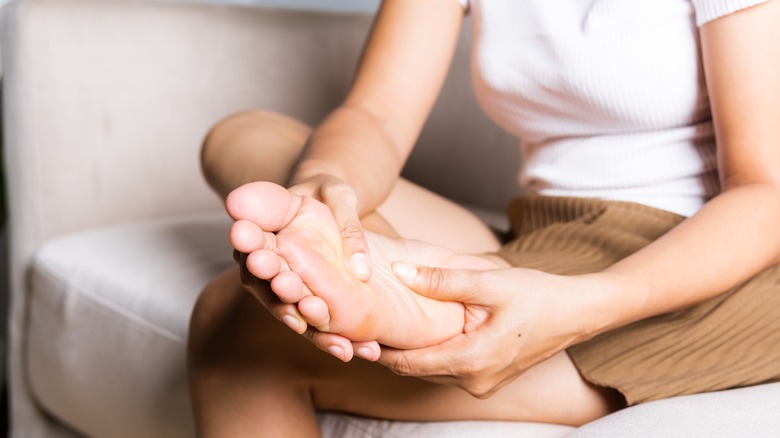What It Means If You Keep Tripping Over Your Toes
At one point or another, we've all stumbled over a curb, rock, or that one final step we thought we cleared as we made our way up a flight of stairs. But, after a moment or two of embarrassment, we recover. What can be a bit more awkward, however, is a public display of tripping over our own toes. While we're all susceptible to the occasional "oops" moment, some people find that tripping over their toes is a recurring problem.
If tripping over your own toes is more of a regular occurrence, you might be experiencing foot drop, sometimes referred to oppositely as "drop foot." People with foot drop have a hard time lifting the front of the foot, most often due to compression of the peroneal nerve (per Mayo Clinic). It's the peroneal nerve that allows us to lift our foot off the floor by facilitating the necessary muscle movements. While peroneal nerve compression can be a result of injury, persistent leg-crossing, extended time spent kneeling or wearing a leg cast for long periods of time can also cause peroneal nerve compression.
What are the potential signs of foot drop?
Because foot drop is not considered its own health condition, it may alternatively be a symptom of muscular dystrophy, cerebral palsy, diabetes, amyotrophic lateral sclerosis (ALS), or multiple sclerosis (MS), among certain other health conditions, all of which can cause peroneal nerve compression (per Anthony Echo M.D.). This compression can also occur as a result of labor or giving birth.
For some people, cases of foot drop may be short-lived; while, for others, the issue may be ongoing. Similarly, some people may experience foot drop in only one foot, while another person may experience it in both feet.
Indicators that a person may be experiencing foot drop include dragging of the toes when walking, a slapping sound each time the foot hits the ground, numbness in the lower leg or top of the foot, as well as weakness in the foot, ankle, or leg. A person with foot drop may also have curled toes.
How is foot drop treated?
Without treatment, foot drop may lead to additional health issues down the line. Therefore, if you notice any developing symptoms, be sure to talk with your doctor. In addition to a physical exam, a series of imaging tests, nerve tests, or blood tests may be used to diagnose the problem (per Penn Medicine).
Many times, foot drop will fully resolve once the underlying condition is treated, although this may not always be the case. Physical therapy may be recommended to help improve muscle strength and range of motion in the knees and ankles. Alternatively, wearing a brace or splint can help keep the foot in proper alignment. In other instances, nerve stimulation or surgical intervention may be the best form of treatment. Surgery may involve the relocation of a working tendon to a different part of the foot or may sometimes involve fusing together bones in the ankle or foot.
To reduce the chances of injury from tripping, practice prevention by removing any tripping hazards along floors — such as wires or area rugs — in order to keep spaces clear and open. Additionally, consider keeping stairs and rooms illuminated, particularly at night.



